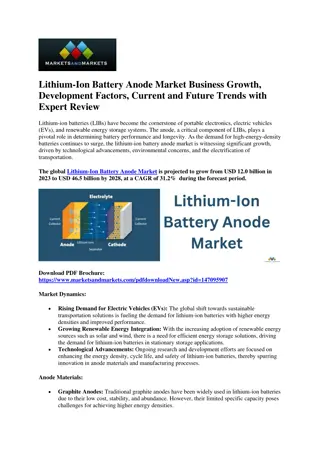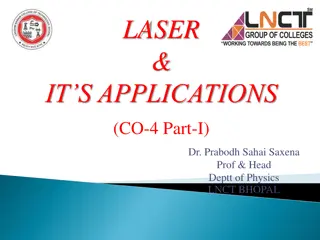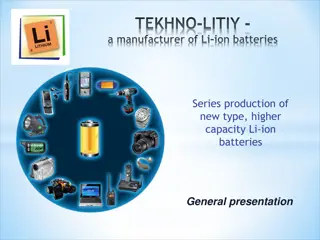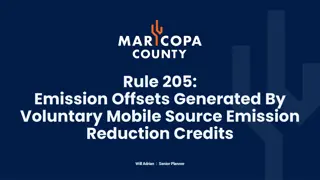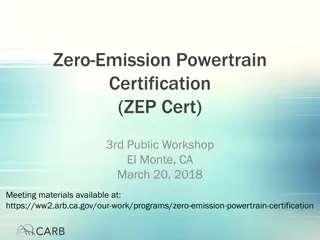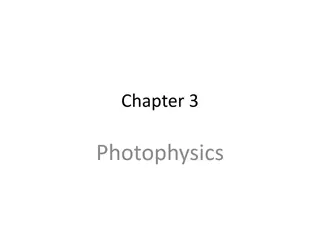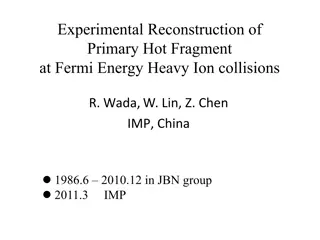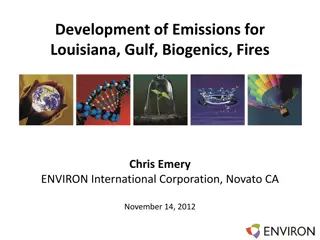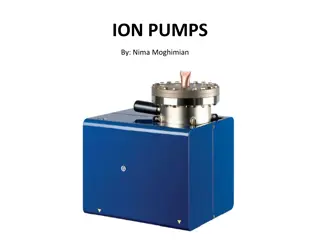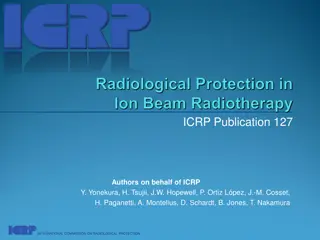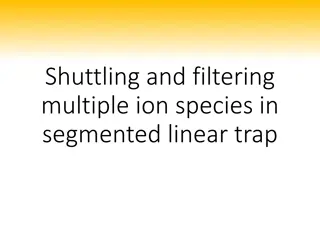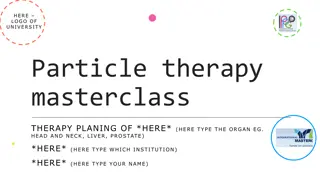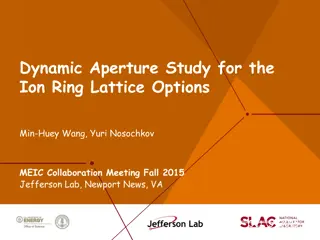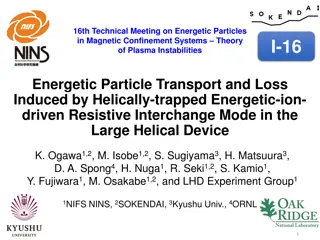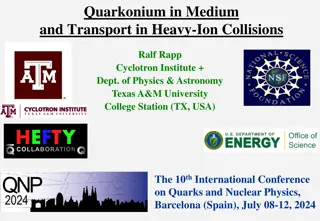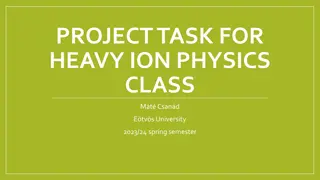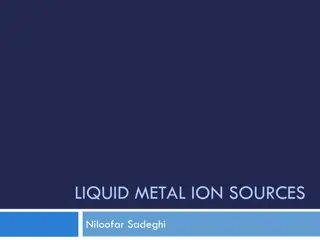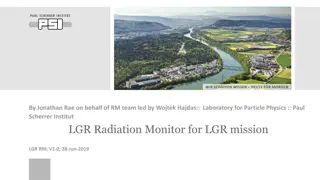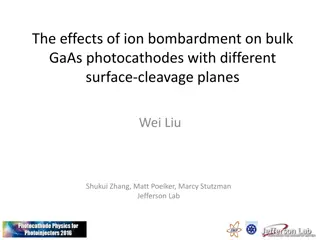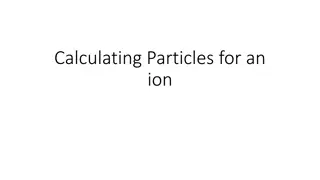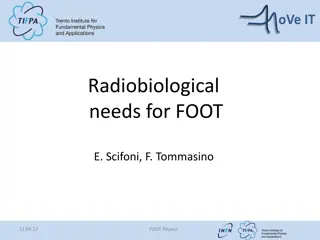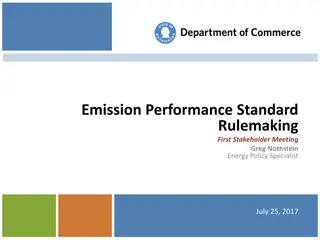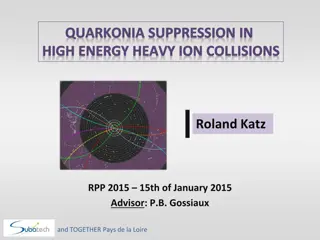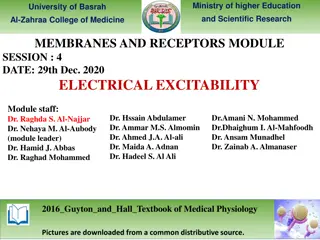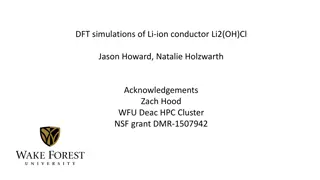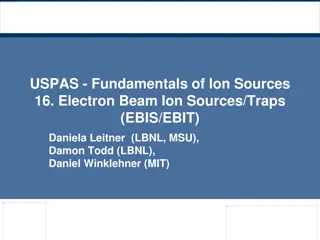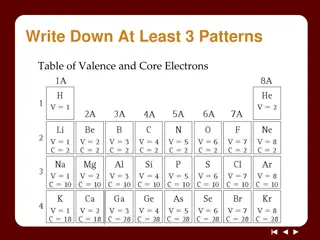Advancing Cyclotron Technology with Internal RF H-Ion Source
Explore the innovative Internal RF H-Ion Source for Cyclotrons funded by Horizon 2020. Revolutionize cyclotron technology with efficient ion production. Enhance beam quality and stability for advanced applications in research and industry.
0 views • 8 slides
Lithium-ion Battery Market
The global lithium-ion battery market size was valued at $46.2 billion in 2022, and lithium-ion battery industry is projected to reach $189.4 billion by 2032, growing at a CAGR of 15.2% from 2023 to 2032.
5 views • 6 slides
Developing the CAST Highlight CO2 Emission Estimator (Beta) - February 2024
CAST Research Labs studied the impact of removing green deficiencies detected by CAST Highlight on CO2 emissions and energy consumption in custom software applications. The study led to a formula for estimating potential CO2 emission reductions, which was integrated into the new CAST Highlight CO2 E
0 views • 11 slides
Lithium-Ion Battery Anode Market Analysis Competitive Landscape & Growth Factors
Europe stands out as the world's number two consumer of lithium-ion battery anodes by value. This robust market is fueled by the growing demand for electric vehicles (EVs) within the region. Government incentives and funding play a crucial role in promoting EV adoption, which in turn, translates to
1 views • 4 slides
Introduction-to-Lithium-Batteries
We have access to higher lithium batteries for solar applications. We manufacture lithium-ion solar batteries, used in inverter batteries and electric automobiles\nWe have access to higher lithium batteries for solar applications. We manufacture lithium-ion solar batteries, used in inverter batterie
0 views • 8 slides
Lithium-Ion Battery Anode Market Size, Share, Industry Analysis and Segments
The global Lithium-Ion Battery Anode Market is projected to grow from USD 12.0 billion in 2023 to USD 46.5 billion by 2028, at a CAGR of 31.2% during the forecast period. The lithium-ion battery anode market is experiencing significant growth driven by the increase in demand for EVs, consumer elect
1 views • 5 slides
Efficient Stack Emission Monitoring Procedure for Air Quality Control
Stack emission monitoring is crucial for industries to assess and reduce pollutants in exhaust air. This procedure involves tasks like measurement, testing, and analysis of flue gases. Sampling sites are selected strategically for accurate readings, and molecular weight and gas velocity are determin
1 views • 11 slides
Understanding Laser Technology: Principles, Applications, and Einstein's Coefficients
Exploring the fascinating world of lasers, this content delves into the principles governing laser technology, including the concept of stimulated emission by Einstein. It covers the characteristics of lasers, different types, and the significant contributions of pioneers in the field. The explanati
0 views • 14 slides
Understanding Reference Emission Level in REDD
REDD (Reducing Emission from Deforestation and Forest Degradation) involves a system for producing carbon credits, including steps like setting baseline emission levels, devising deforestation reduction strategies, monitoring changes, managing carbon credit sales, and distributing income. Organizati
0 views • 10 slides
Advancements in Li-ion Battery Technology by Tekhno-Litiy
Tekhno-Litiy, a prominent manufacturer of Li-ion batteries, introduces higher capacity batteries with exceptional advantages such as high energy density, no memory effect, low self-discharging, and fast charging. They excel in the production of second-generation Li-ion batteries based on nano-struct
0 views • 5 slides
Compliance Guide for Rule 205: Emission Offsets & Mobile Source Credits
Rule 205 outlines the process for generating emission offsets through voluntary mobile source emission reduction credits in Maricopa County. The rule-making process, state implementation plan submission, and permit conditions related to Rule 205 are discussed. The preparation for compliance includes
0 views • 7 slides
Understanding the Principle and Working of Semiconductor Lasers
Semiconductor lasers operate through absorption, spontaneous emission, and stimulated emission processes. Absorption of radiation causes electrons to jump to higher energy levels, leading to light emission. Spontaneous emission is when excited electrons return to ground state by emitting photons, wh
3 views • 17 slides
Zero-Emission Powertrain Certification Workshop Highlights
Workshop materials and agenda from the Zero-Emission Powertrain Certification 3rd Public Workshop held in El Monte, CA on March 20, 2018, discussing the ZEP Cert framework, applicability, testing, monitoring requirements, and more. The workshop aimed to accelerate the adoption of zero-emission techn
1 views • 24 slides
Understanding Ion-Pair Chromatography (IPC): Theory and Applications
Ion-Pair Chromatography (IPC) involves adding ionic surfactants to a reversed-phase Chromatography system to affect retention and selectivity of ionic compounds. Developed by Dr. Gordon Schill, IPC is crucial for resolving hydrophilic samples and controlling selectivity in separations. The theory in
7 views • 18 slides
Understanding Photophysics: Emission and Luminescence Processes
Photophysics explores the emission and loss processes in luminescent phenomena, named based on the excitation mode of energy-rich species. Different types of luminescence include fluorescence, phosphorescence, and chemiluminescence. Bioluminescence in nature, such as in fireflies and dinoflagellates
0 views • 20 slides
Experimental Reconstruction of Primary Hot Fragment in Heavy Ion Collisions
Investigation into primary hot fragment reconstruction at Fermi energy heavy ion collisions, utilizing experimental data and simulations to reconstruct excitation energy, mass, and charge of primary fragments. Techniques like kinematical focusing and isotope identification were employed, with a focu
0 views • 36 slides
Cryogenic Gas Stopping Cell for High Precision Nuclear Physics Experiments
In the field of nuclear physics, high-quality ion beam parameters are essential for both primary and secondary beams. This report focuses on the cryogenic gas stopping cell, also known as a gas catcher, designed to transform rare ion beams from nuclear reactions into low-energy beams with small emit
1 views • 12 slides
Detailed Overview of Emissions Development in Louisiana
Emissions Processing System (EPS3) generates chemically speciated, gridded formats required by CAMx, with a focus on raw annual/ozone season county/parish-level emission inventory files and support data. Spatial and temporal profiles, along with cross-reference files, are essential for this work, co
1 views • 27 slides
Understanding Ion Pumps and High Vacuum Systems
Explore the world of ion pumps and high vacuum systems, including the importance of creating a good vacuum, the different types of pumps available, the significance of ultra-high vacuum environments, and the features of ion pumps. Discover the technologies and processes involved, from chemisorption
0 views • 12 slides
Advancements in Ion Beam Radiotherapy for Cancer Treatment
Ion beam radiotherapy, utilizing protons and carbon ions, offers precise dose localization with minimal damage to normal tissues, leading to effective treatment of solid cancers. This document discusses the benefits, challenges, and safety considerations of ion beam therapy, highlighting its signifi
0 views • 24 slides
Understanding Shuttling and Filtering of Multiple Ion Species in Segmented Linear Trap
This content delves into the intricate processes of shuttling and filtering multiple ion species within a segmented linear trap. It explores techniques such as RF filtering, DC potentials, mass filtering, and trap depths in the context of ion manipulation. Discussions also touch on ion crystal phase
0 views • 13 slides
Understanding Ion Channels in Cell Communication
Ion channels play a crucial role in cell communication by allowing ions to pass through cell membranes, controlling various cellular functions. Their high transport rate and electrochemical gradient differentiate them from other ion transporter proteins. Ion channels have diverse biological roles, i
0 views • 26 slides
Comparison of Photon, Proton, and Carbon Ion Therapy for Liver Cancer
This document elaborates on the comparison of photon, proton, and carbon ion therapy for liver cancer. It includes abstract, phantom CT scan analysis, organ delineation, photon vs. proton therapy comparisons, and proton vs. carbon ion therapy comparisons with corresponding images. Detailed discussio
0 views • 11 slides
Ion Beam Intensity Enhancement Through Electron Heating in Collider Experiments
The study discusses electron heating of ions in collider experiments at the Collider V. ParkhomchukBINP facility in Novosibirsk. It explores the effects of electron cooling on ion beams, ion beam oscillations, losses, and ion beam intensity enhancement. Various factors such as ion charge, classical
0 views • 9 slides
Dynamic Aperture Study for Ion Ring Lattice Optimization
This study focuses on optimizing the dynamic aperture of the ion ring lattice, covering topics such as correct chromaticity, aperture scanning, effects of alignment and field errors, and correction procedures. The comparison of various lattice schemes provides insights into aperture characteristics,
0 views • 25 slides
Study on Energetic Particle Transport and Loss in Magnetic Confinement Systems
Investigation into energetic particle transport and loss induced by helically-trapped energetic-ion-driven resistive interchange modes in the Large Helical Device (LHD) for sustaining high-temperature and high-density plasmas. Utilizing neutron diagnostics and comprehensive neutron monitors, this st
0 views • 21 slides
Applications and Importance of X-ray Fluorescence Spectroscopy in Analytical Chemistry
X-ray Fluorescence Spectroscopy (XRF) is a vital analytical technique used for qualitative and quantitative analysis of elements based on their X-ray emission characteristics. Dr. Uma Sharma, a Professor at Vikram University, details various X-ray analytical methods, including X-ray emission, Auger
0 views • 21 slides
Quarkonium in Medium and Transport in Heavy-Ion Collisions
Discussing the properties and behavior of quarkonium in medium and its transport in heavy-ion collisions. Topics include heavy-quark potential, confinement, quarkonia at finite temperature, quarkonium transport, and quarkonia in heavy-ion collisions. Insightful details about in-medium potential and
0 views • 30 slides
Project Task for Heavy Ion Physics Class at Mt. Csand Etvs University 2023/24 Spring Semester
This project involves analyzing real data from ultrarelativistic heavy ion collisions to measure physical observables such as elliptic flow (v2) or HBT radii (R) versus pT and centrality. It includes working with ROOT format data, setting up C++ and ROOT environments, installing necessary tools, and
0 views • 17 slides
Understanding Liquid Metal Ion Sources in Nanotechnology
Liquid Metal Ion Sources (LMIS) are crucial tools in nanotechnology, with needle and capillary types for ion emission. LMIS operate on the formation of liquid metal cones to emit ions, driven by electric fields and surface tension. Taylor cones and strong electric fields play key roles, while stabil
0 views • 10 slides
Advances in Radiation Monitoring Technology for Space Missions
Cutting-edge radiation monitoring technology developed by Jonathan Rae and the team at the Laboratory for Particle Physics, Paul Scherrer Institut, aims to provide in-situ measurements of protons, electrons, and ions for space missions. The LGR Radiation Monitor (RM) features improved detection tech
0 views • 8 slides
Ion Bombardment Effects on GaAs Photocathodes
Examining the impact of ion bombardment on bulk GaAs photocathodes with different surface-cleavage planes. Ion back-bombardment in photo-gun setups is a significant factor limiting the operating lifetime of photocathodes. Investigation includes H-ions implantation into GaAs, experimental apparatus d
0 views • 14 slides
Understanding Ion Calculations for Iron Element
Learn how to calculate the particles for an ion of iron (Fe) using the periodic table, including the number of protons, electrons, neutrons, and the mass number. Understand the notation of isotopes and how to determine the charge of an ion. Get the final answers for the Iron isotope with atomic numb
0 views • 10 slides
Advancements in Biological Treatment Planning for Ion Beams
Exploring the integration of biological effect information in treatment planning for ion beams, this collection of research discusses the importance of proper data accounting for enhanced patient-specific planning and beam selection. Topics include radiobiological needs, target and projectile fragme
0 views • 18 slides
Washington State Emission Performance Standard Rulemaking Stakeholder Meeting Overview
This document provides detailed insights into the first stakeholder meeting regarding the Emission Performance Standard Rulemaking in Washington State. It covers key agenda items, reviews of RCW 80.80 GHG Emission Performance Standard, definitions related to CCCT and baseload electric generation, an
0 views • 19 slides
Quarkonia Suppression in High Energy Heavy Ion Collisions by Roland Katz
Investigating the phenomenon of Quarkonia suppression in high energy heavy ion collisions, Roland Katz explores the properties of Quark Gluon Plasma and the behavior of quarks and gluons under extreme conditions. The study delves into the dynamics using the Schrödinger-Langevin equation, highlighti
0 views • 23 slides
Understanding Membrane Excitability in Action Potentials
Explore the mechanisms of action potentials in nerve fibers, including the all-or-nothing principle, ion channels involved, ion movement, and effects of drugs on action potentials. Learn about accommodation, refractory periods, and consequences of blocking ion pumps on nerve conduction.
0 views • 8 slides
Understanding Lithium Ion Conduction in Li2(OH)Cl Through DFT Simulations
DFT simulations were conducted on the lithium ion conductor Li2(OH)Cl to investigate its low and high-temperature phases. The motivation behind the study was to uncover the structural features impacting the phase transition and diffusion properties of the material. The background highlighted two pha
0 views • 16 slides
Fundamentals of Electron Beam Ion Sources for Ionization: A Comprehensive Overview
Delve into the intricacies of Electron Beam Ion Sources (EBIS) and Electron Beam Ion Traps (EBIT) with a focus on their historical development, key operating principles, and main concepts. Explore the production of high charge states for accelerator applications, electron beam confinement, ionizatio
0 views • 10 slides
Understanding Ionic Bonds: Valence Electrons and Ion Formation
Exploring the concepts of valence and core electrons, Noble Gas Envy Ions, and the formation of ions through electron transfer between metal and nonmetal atoms. Learn about cations and anions, ion charges based on the periodic table, and the relationship between ion charge and valence electrons.
0 views • 13 slides



